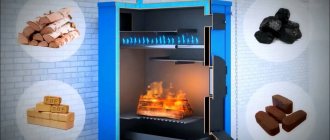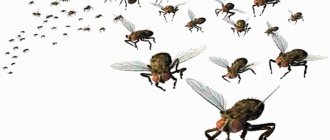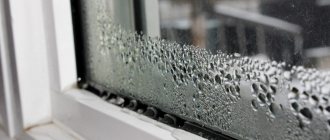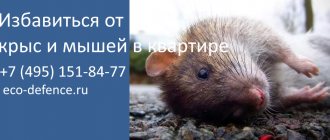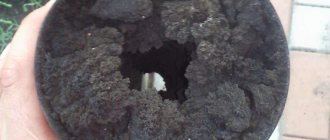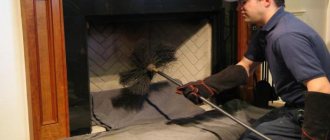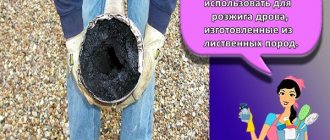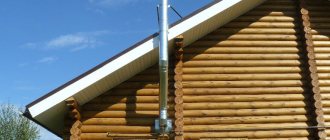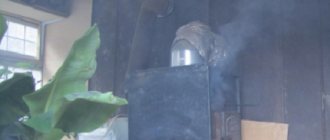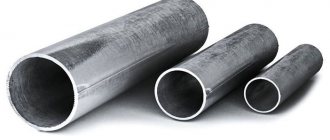Owners of apartments or houses with gas heating will not be interested in the topic of this article, but those who use any solid fuel for heating are well aware that sooner or later, soot accumulates in the chimney, and what consequences this can entail. In this article we will talk about the causes and how to remove soot from the chimney.
Reasons for its appearance and what it means
The reasons for the formation of soot in the chimney can be very different, and often this is a consequence of improper operation of the stove device. Let's list the most common causes:
- Using raw firewood or fuel briquettes.
- Incorrect chimney configuration, preventing the normal passage of smoke.
- A large number of irregularities on the inside of the pipe.
- Pollution and littering of the chimney during the time when it is not in use.
- Burning various household waste and especially plastic in a furnace.
- Frequent change of wood species burned in the firebox.
In fact, these are not all the causes of soot, but they are the most common.
Advice! To fire a stove or fireplace, you need to use only well-dried firewood, aged for at least one and a half years.
Consequences of soot accumulation
Often, homeowners neglect cleaning the chimney, and in vain, since in addition to the basic deterioration of draft, this can lead to a number of sad consequences, some of which can not only cause harm to health, but can also lead to death.
We are now talking about the absence of draft and penetration of carbon monoxide into the room. Its danger lies in the fact that, unlike smoke, which has a characteristic odor, carbon monoxide has no odor at all, but at the same time it is deadly to health and life. But that’s not all, here are just a few possible scenarios for the development of events with a clogged chimney.
- The soot that accumulates in the chimney can sooner or later flare up and with poor brickwork, high temperatures can lead to a fire in the roof, as shown in the photo above.
- The narrower the chimney passage, the more sparks escape from the tip. In strong winds, both the roof itself and the surrounding buildings may catch fire.
- ignition of soot in the chimney can lead to strong backdraft, as a result of which the fire will go inside the room and it will be very difficult to stop it.
- A thick layer of soot will accelerate the wear of the brickwork.
- Carbon deposits prevent uniform heating of the fireplace and chimney, resulting in a significant reduction in the efficiency of the device.
These and many other factors sooner or later make every homeowner wonder how to deal with soot in the chimney, and this is what will be discussed below.
Important to remember! Experts advise carrying out preventive cleaning of the chimney at least twice a year; this will not only extend the life of the stove or fireplace, but will also allow you to clean it yourself quickly and without much difficulty.
Chimney cleaning products
Chemical and mechanical means for cleaning the chimney have already been mentioned above; This is where their selection is limited. “Anti-soot chemistry” is applicable to chimneys that have not been neglected (in terms of maintenance) with a soot coating no thicker than approx. 2 mm; in other cases you have to use mechanics
Anti-soot chemistry
Chemical products are intended for use by the owners themselves without the involvement of specialists and cope with a thin coating of any soot of any kind. “Chemistry for soot” cleans not only the chimney, but also the entire smoke system. For devices with complex thermal circuits (which are the most economical) this is more than relevant. Prevention against soot loss is also possible only with chemical means. In addition, “dry cleaning” of the stove is the cleanest in the literal sense: a relatively small amount of cleaned soot falls into the firebox, from where it can be removed without dirtying the room; Most of the soot burns and flies out into the chimney.
The action of chemical soot removal products is based on the release of catalysts into the flue gases, provoking the combustion of its bituminous components. Typical composition of “soot chemistry”:
- Amorphous silicon (inhibits, i.e. suppresses the combustion of carbon).
- Wood sawdust (emit volatile flammable substances that initiate the ignition of bitumen).
- Urea (urea) plays the role of nitrate: when heated, it releases oxygen. Nitrate itself (any kind) cannot be used in this composition - it can detonate in contact with carbon and in the presence of catalysts!
- Ammonium and sodium sulfates provide catalyst ions.
- Coal wax - spreading in a layer of soot, ensures uniform combustion.
Note: urea is also, in principle, an explosive substance. In the Bond film “All World is not enough”, under the Western name “urea”, a terrorist blows up MI6. But they used some kind of Hollywood-style fantastic detonator, but in general it is extremely difficult to make urea detonate even in special installations.
Creosote and other bituminous substances are enough for even the plumpest soot. After they burn out, non-sticky amorphous carbon and graphite remain, which crumble down. This leads to an important drawback of chemical soot removers: the chimney must be designed for elevated temperatures. If the upper part of the pipe is built on ordinary cement mortar or made of asbestos-cement pipe, then the use of chemical soot cleaners can render it completely unusable. And if you try to “chemically” remove a thick coating of plump or greasy soot, then the likelihood of it catching fire is very high.
Chemical soot removers are available in the form of powder (left in the figure), briquettes and logs (center and right):
Chemicals for preventing soot deposits in the chimney and cleaning it
Powders are used for prevention; the ratio of ingredients in them is different than in compressed formulations. The powder is sprinkled on the logs loaded into the firebox in layers before kindling according to the instructions included with the package. The device starts up and operates in normal mode; It is possible to regulate combustion by air supply and draft using a damper. If you buy a powder recommended for the type of fuel you use, then you will only need scheduled seasonal chimney cleanings listed above.
A briquette and a log for cleaning a chimney from soot differ only in shape and are used for “impact” unscheduled chemical cleaning. They are used differently, because They act only on hot soot: standard fuel is loaded into the firebox and they wait for it to burn out, but not completely go out. Then they throw a cleaning log into the firebox, close its door and completely open the vent with the damper. The device is kept “in the air” for 2-3 hours (more precisely, according to the instructions), i.e. the stove/boiler gets cold and this fuel load does not provide useful heat.
Note : how to use chemical soot removers, see the video:
Video: chemical cleaning of the chimney
and user reviews about them follow. video:
Village chemistry
Our ancestors discovered chemical prevention and removal of soot from chimneys long before they appeared on the market as new chemical technology products. Folk remedies for preventing soot deposits in the chimney and cleaning it from it are as follows:
- Potato peels - for the prevention of soot, similar to chemical powder;
- Table salt - the same;
- Aspen firewood - for “impact” cleaning of small soot deposits.
Potato peelings are dried until brittle before being added to fuel. Catalysts for the burnout of soot bitumen are organic products of the joint pyrolysis of starch and the alkaloid solanine; Solanine is contained in the peel, sprout and green parts of the tubers, which is why they are all poisonous. The tops of potatoes and other nightshade plants (for example, tomatoes) contain even more solanine, but there is no starch and they are not suitable for preventing soot. Also unsuitable are products containing only starch, for example, rice, and cleaning root vegetables without alkaloids containing sugar (beets, turnips, etc.) will only aggravate soot deposition. In principle, peeling the root crops of yams, sweet potatoes and taro would work against soot, but they don’t grow here, and where they grow, there is no problem with cleaning chimneys due to the lack of need for seasonal heating.
Note: organic catalysts for burning bitumen are more active than mineral ones, so removing a lot of plump and greasy soot with potatoes is even more dangerous than using “chemistry.”
During thermal decomposition, table salt releases sodium ions - catalysts, but in the singular without additional additives they act weaker. But you can try to loosen thick, plump and greasy soot with salt without stopping the furnace: if it doesn’t work, then nothing bad will happen. Just don’t expect an immediate effect - soot starts falling into the firebox 1-3 days after burning salted wood.
Aspen firewood
Aspen firewood (see figure on the right) to remove soot is used at room dryness, i.e. After the wood burning, they need to be kept for at least a month in a dry, heated room. Aspen fuel is low-calorie, but when burned it develops a high temperature, up to 1200 degrees, which is why it is used to accelerate brick kilns. The aspen firebox acts on soot (including thick, plump and greasy) purely thermally: the bitumen is heated to the point of fluidity and the soot falls off. Firing aspen firewood from soot gives an immediately visible effect, but you need to load aspen firewood into the stove no more than half of the norm (by weight), otherwise the structure of the stove may not withstand overheating.
Note: for “rustic” methods of preventing soot in the chimney and removing it from there, see the video:
Video: traditional methods for removing soot
Mechanical cleaning products
Mechanical cleaning of the chimney is carried out, firstly, in the order of its routine inspection and maintenance in the fall and spring. Secondly, if urgent cleaning is necessary during the heating season with the furnace/boiler stopped, because... Mechanical cleaning while the device is running is not possible. Mechanical cleaning is labor-intensive; A lot of dirt gets into the room. It is impossible to clean the stove/boiler mechanically at the same time as the chimney. Mechanical prevention of soot is also impossible: mechanical cleaning of the chimney is carried out only after it has been contaminated. When cleaning with mechanical methods, the likelihood of damage to the chimney is not small. But by mechanical means it is possible to remove the oldest soot, even if it has completely blocked the lumen of the pipe, without the risk of causing it to catch fire and/or overheating of the device.
Note: machine cleaning of the chimney (briefly described above) is for professionals, because... keep at home in reserve just in case, resp. installation is pointless. If an ordinary householder dares to clean the chimney himself, he will have to do it manually.
Top or bottom?
Mechanical devices are used to clean the chimney from above (from the roof) or from below (from the furnace/boiler firebox). Top cleaning may not allow dirt into the room at all, because... Most of it is removed outside, but it is dangerous and is only possible under favorable weather conditions. As a rule, the chimney is cleaned from above in the order of autumn-spring inspection. After the bottom cleaning, the room will be full of soot, but climbing to the roof is not necessary. Therefore, urgent/emergency winter cleaning of the chimney is carried out from below and the device is stopped. In both cases, the working body of a manual cleaning tool will be a brush or brush.
Ruffs...
Cleaning the chimney with a brush is the most accurate; It is strongly recommended to clean sandwich chimneys manually only with a brush. But cleaning with a brush is also the most labor-intensive: on average, routine cleaning of a 4 m long pipe takes 40 minutes, and urgent cleaning takes more than an hour. It is unlikely that it will be possible to remove light gray and old gray soot with a brush.
Brush for cleaning chimneys
The chimney is cleaned with a brush most often without rotation; in this case, the working element is fixed on a long flexible cable in a slippery shell (on the left in the figure). Clean the pipe with a brush, screwing it up and down; The cleared soot is scattered wherever necessary. The spines (bristles) of the brush can be steel or plastic. A steel brush cleans both plump and greasy soot, but scratches the pipe. A plastic brush gets stuck in greasy soot or slides on it, but it can be used to clean not only sandwiches, but also cast ceramics and glass. However, now chimney brushes with spines made of propylene fishing line for brush cutters are increasingly coming into use; they combine the advantages of steel and plastic brushes without their disadvantages.
Note : a brush with spines made of hard, inflexible thick steel wire (see figure on the right), the so-called. garnish, is used in exceptional cases for cleaning thick-walled steel chimneys, but it scratches them so much that then the deposition of soot accelerates significantly.
A brush-brush (item A in the previous figure) with 2-3 turns is also called a single or fine-cleaning brush: with it alone you can remove only thin, fresh, plump soot, and from the others it only scoops out residues that have been loosened and/or softened by chemical or hydrocleaning. The cleaning brush does not fit through the fractures of the chimney - there are few spines, they are crushed and do not hold the rod, which rests on the fracture.
A one-and-a-half-turn brush with 4-5 turns (pos. B) is most commonly used, because It takes plump, greasy and not old gray soot and passes through the cracks at least 120 degrees. However, even with scheduled seasonal cleaning, they have to move for up to an hour or more. A one and a half brush is also called a one and a half brush and is often attached to a cleaning device with a ball (see below), which is also called a one and a half brush. A full brush with 6 or more turns (pos. B) is suitable for cleaning only straight pipes, incl. barbell (also see below), but reduces the operating time by approx. 1.5 times compared to one and a half.
...and brushes
Brushes for manual chimney cleaning
A chimney brush differs from a brush in that its spines stick out in bunches without forming spiral surfaces. Therefore, you can use a brush to clean the chimney with rotation: the awns do not crush or cut into soot and do not get stuck in it.
Brushes for manual chimney cleaning (see figure) are not the same as for machine cleaning (see figure above), and replacing hand brushes with machine ones is unacceptable: a machine brush should rotate much faster than a hand brush, and you will ruin the chimney with your hands more than you will remove soot . Brushes for manual cleaning of conventional chimneys are available with a through axial hole for mounting in a one-and-a-half-barrel (item and 2 in the figure) or with a threaded tip for installation on flexible rods (item 3) for cleaning from below or above, or on a rigid rod for cleaning only from above. In terms of length, location of the spines and action, both do not differ, but the drum brush for sandwich chimneys is designed differently, pos. 4. It is not recommended to replace it with a simple one, because otherwise, the brush core or the load of a half-barrel can damage the thin-walled pipe.
Note: When using a hand brush on the rod, be careful where you twist. If the brush unscrews and remains in the chimney, it will be difficult to remove it back.
Cleaning from below...
A non-chimney sweep most often has to clean the chimney from below with his own hands - in winter, urgently, when the roof is snowy and/or icy and calling a specialist is too expensive or even problematic. For lower cleaning, a brush (better if it takes soot) or a brush is screwed onto a rod and, building up the unit with them, they gradually push it into the chimney until the working element comes out of the mouth of the pipe (this can be felt well). If it gets stuck, carefully poke and twist: flexible rods with a one-and-a-half brush bend at 120 degrees, and with a brush at 90 degrees.
If you are working with a brush, then you need to move slowly to the full length, moving back and approaching again until the soot stops pouring out in a stream. Be patient: an hour and a half to clean the bottom of a 4-meter chimney with a brush is still fast.
If you work with a brush for the sake of speed, the next stage is the most interesting. A standard handle is placed on the last rod, or the end of the rod is secured in the drill chuck. The tool is switched to right (direct) rotation so that the rods seem to be screwed into each other and into the brush, the speed control is set 2-4 clicks from zero and moves back, rotating the entire system. One pass will most likely be enough, because... In winter, soot cokes slowly, but how much of it will fly into the room... you can imagine, but you don’t need to. And if it goes to such an extreme, you will see for yourself. Therefore, carpets, furniture and everything valuable from the room must be removed in advance, and the walls should be covered with film, secured with tape. It is difficult to hang a ceiling, so plan to re-whitewash it in the spring, and it is better to remove the false ceiling: stove soot eats into all finishing materials.
...and from above
Two scheduled cleanings a year will save you at least 20 thousand rubles, so let’s see how a chimney is cleaned mechanically from the roof. This can be done with a brush on the rod(s), or with a ball (one and a half brush) with a brush, depending on the type of soot and the degree of contamination of the chimney.
Dense gray soot builds up and the lumen of the pipe narrows slowly, so in this case it is better to clean with a brush. Cleaning is done in reverse: without rotating, the brush is slowly inserted into the chimney channel, trying to knock down as little soot as possible (pos. 1 in the figure), and then pulled up faster and rotating (pos. 2), pulling the soot out. If the firebox and vent of the stove are closed, and the fireplace portal is tightly curtained, very little soot will get into the room, but carpets, furniture and valuables still need to be removed in advance.
Cleaning the chimney from above (from the roof)
The chimney brush will not quickly pick up soot in the corners of a rectangular channel; square brushes are nothing more than a marketing ploy. To speed up the work, you can clean the corners with a hard household or bench brush on a pole, pos. 3, but the remaining soot will then fall down and it will take more time to rake them out of the firebox. For the same purpose, thick, dense and/or lumpy soot deposits are loosened with a hook (item 4) before using the brush; it also removes foreign objects.
A special case is cleaning a ceramic chimney. Soot adheres weakly to cast ceramics, but sharp scratches on its inner surface, even very small ones, accelerate its deposition and adhesion to the base to the point that the expensive chimney begins to require replacement. Therefore, ceramic chimneys are cleaned with a special so-called. smooth brush with blades made of steel spirals, pos. 5.
Note: it is more convenient, faster and cleaner to remove gray light, old or greasy soot from a round steel chimney using a disc scraper, see video:
Video: a simple and effective method for cleaning a pipe
What if you joke around?
If you don’t mind the time and effort of cleaning, and the chimney is straight, then you can clean it using the one-and-a-half-piece back-and-forth method. A little soot will also get into the room, but the risk of damaging the chimney duct is minimal. A very dense soot succumbs to the top of the one-and-a-half, which almost completely or completely covers the lumen of the pipe, because the weight (ball) of the device participates in cleaning, breaking and loosening soot deposits; the ruff removes it more and brings it down. To do this, they use the shock method: a half-truck is lifted on a cable and thrown. For these reasons, chimney sweeps of the past preferred to work with one and a half and were depicted with it.
You can make a one-and-a-half piece for cleaning the chimney with your own hands by purchasing only a brush and/or brush for it. But you shouldn’t use a sports weight as a load: it can get jammed in the channel (see figure below), which will almost certainly result in damage to the chimney and increased deposition of soot in it in the future. See the same fig for how a one-and-a-half-wheeler is properly constructed.
One and a half chimney cleaning device
Note: about cleaning the chimney with a homemade one and a half sheet, see the video:
Video: one and a half sheets for cleaning a chimney
Chimney cleaning
Today, with the growing popularity of fireplaces in private homes, the profession of a chimney sweep is becoming increasingly in demand. Of course, the price for their work is often very high, so many people decide to clean the chimney themselves.
Below we will provide detailed instructions and describe several methods, the choice of which depends on personal capabilities and the degree of contamination of the chimney. For example, traditional methods or chemical cleaning methods are most often possible only at the very beginning of the build-up of soot, but if a lot of soot has accumulated, then you will have to resort to mechanical cleaning, and this is the most complex and time-consuming method, but first things first.
Traditional methods
Most traditional methods are based on burning soot in the chimney, and therefore, it is necessary to increase the combustion temperature to such an extent that the soot ignites without starting a fire in the ceilings. That is why, before using one of the listed methods, you need to make sure the quality of the pipe laying.
- Rock salt. One of the most popular methods by which soot is burned out of a chimney. Salt is poured onto the burning wood and the firebox is closed. The temperature in the vent will rise and the soot will flare up, while some of it will burn without a trace, and some will fall down.
- Potato peelings . At first glance, the method may seem strange, but in fact, everything is simple - the starch in potatoes softens the hard soot and it ignites. The main difficulty of this method is that it is very difficult to calculate the required number of cleanings, but on average they take one full bucket per ignition, after which they check the condition of the chimney and, if necessary, repeat the procedure.
- Aspen logs . The fact is that this tree has the highest combustion temperature, so if you fill the firebox with aspen logs, soot will burn out from the chimneys, but this must be done very carefully, since the temperature in the solid fuel stove and chimney will be very high.
- Turpentine . Another method was very popular in the past; firewood is generously watered and set on fire, which creates intense heat, which removes soot from chimneys.
- PHC. A domestic product produced in the form of a powder, packaged in 50 gram bags. The contents of one package must be poured onto the firewood and lit. The active substances in the product will react with carbon deposits and decompose it into its constituent components, which will burn out without a trace.
Important! Burning soot in chimneys is a very dangerous method, so it can only be done on a slightly smoked chimney and as a preventive measure or preparation for the main cleaning.
Chemical method
Today, products for chemical removal of soot in the chimney are presented in a huge assortment, so it’s easy to get confused when choosing the one that actually works. We will present an overview of several popular products that have proven themselves over the years.
- Log chimney sweep . This is a solid composite material, the convenience of which lies in the fact that it is simply added to the firebox with ordinary firewood and burns with it. Stove specialists advise using it as an aid before removing soot from the chimney. You need to add a chimney sweeper to the stove twice a year for prevention, and this significantly extends the service life of the chimney and prevents the formation of soot.
- Kominichek , a Polish-made chimney soot remover. The main component of this product is copper oxide, which dissolves accumulated soot.
Important! Chemical cleaning methods, as well as traditional ones, cannot be used when there is a large accumulation of soot, as this is fraught with consequences. Most often they are used only as a preventive measure or as an adjuvant before mechanical cleaning.
SOOT IN THE CHIMNEY! WHAT IS THE DANGEROUS AND HOW TO DEAL WITH IT?
What is Soot?
This is a product of incomplete combustion of carbohydrates in the furnaces of heat-generating apparatuses, formed when the combustion temperature is insufficient and (or) when there is insufficient air.
Soot is finely dispersed, almost pure (technical) carbon, the crystal lattice of which consists of hexagons with carbon atoms at the vertices. The crystals make up curved layers, which determines the almost spherical surface of its particles. The density of soot particles is 2 g/cm3. The average number of crystals in one soot particle varies from 1.6 to 5.4 thousand pieces.
Bulk density, depending on compaction and humidity, 0.05-0.5 g/cm3. The surface can be either rough or smooth.
The chemical composition of soot contains up to 98% carbon, small impurities of minerals and sulfur. Also, the composition of soot deposits may include oxygen, up to 10% by weight, aromatic resins and compounds of various substances.
Most often, the soot formed on the walls of heat-generating apparatuses and chimneys does not have chemical and laboratory purity, due to its mixing with tar deposits, contamination with dust and fly ash.
The production and use of soot will not be considered within the scope of this article.
So what are the dangers of soot deposits building up in your chimney?
1. Danger! Fire!
In the presence of atmospheric oxygen, under the influence of high temperatures and from an open combustion source, soot is capable of burning intensely, releasing a large amount of heat. Combustion temperature from 800 to 11000C.
If soot ignites in a chimney, building structures may ignite if nearby combustible materials are not properly protected. Also, a potential fire hazard is posed by the scattering of sparks from the mouth of the pipe or through leaks in the channel walls.
With prolonged and intense burning of soot, the chimney materials are subject to increased wear and may become completely unusable.
2. Danger! Narrowing of the pipe section!
Soot deposits on the walls of the channels can significantly reduce the cross-section of the pipe, which leads to a decrease in the throughput of the chimney, incomplete removal of combustion products through the chimney into the atmosphere, and provokes smoke emissions into the room.
As a result of incomplete removal of flue gases from the furnace, incomplete combustion of fuel will occur, which will not only aggravate the formation of soot, but will also create conditions for the release of carbon monoxide.
The entry of a mixture of flue gases containing carbon monoxide into residential premises poses a deadly threat of poisoning! Dangerous!!!
3. Danger! Chimney blockages!
The soot deposited on the surfaces of chimneys, supplemented by dust, ash and debris, gradually wakes up and can completely block the cross-section of the pipe, forming a blockage - a dense plug.
When the device is operating, this will lead to inevitable smoke in the premises and can cause poisoning by combustion products, even death.
4. Soot destroys the walls of chimneys! Dangerous!
Soot adhering to the walls of smoke channels, mixing with condensate, under the influence of high temperatures creates all the conditions for the formation of an aggressive environment that destroys chimney materials.
There is a risk of loss of functionality of the chimney and the inability to use the stove (fireplace or boiler), which not only threatens the cost of remodeling it, but also creates the risk of losing all property from a fire that occurs due to untimely replacement or repair of a destroyed chimney.
5. Soot causes stoves to overheat! Dangerous!
The soot that falls on the walls of chimneys and smoke circulations of furnaces acts as thermal insulation, preventing the furnace mass from warming up.
Because of this, the consumer begins to consume more fuel, receiving increased amounts of soot and additional economic costs. At the same time, it begins to burn in an even more intense mode, leading to the ignition of soot in the channels and to overheating of the stove and chimney. Which creates the danger of both fire and poisoning.
6. Soot in the air is dangerous!
Soot particles, due to the fine structure of their surfaces, pose a danger to the mucous membranes of the respiratory tract and eyes.
Soot belongs to hazard class 3.
Maximum permissible concentration of the substance, mg/m3.
Maximum one-time – 0.150
Average daily – 0.05
This should be taken into account both during operation and when organizing work on cleaning Fireplaces, Stoves and Chimneys.
It is necessary to use protective curtains on the combustion space (especially open fireplaces), or the area around the stove being cleaned. The chimney sweep performing the work must be provided with personal protective equipment for the eyes and respiratory system.
What circumstances influence the amount of soot in the stove and chimney?
1. The amount of soot formed depends on the completeness of fuel combustion.
The following factors influence this:
- Type of fuel;
(different types of fuel, depending on their chemical composition and the amount of impurities, have the ability to burn or not burn completely. When burning one unit of fuel, they can emit different amounts of soot and soot.);
- Fuel quality
;
(Fuel with a high moisture content or contaminated combustion produces more soot compared to clean and dry fuel.
This also includes fuel contamination by ash that is not removed in a timely manner)
- Incomplete and untimely removal of flue gases from the furnace;
(Prevents the flow of fresh air into the combustion chamber, which causes underburning of the fuel with the release of soot and soot)
- The amount of air entering combustion
;
(It is important to ensure a sufficient amount of it, necessary for complete combustion of the fuel. However, it should be remembered that there should not be too much of it. This can lower the combustion temperature, supercool the flue gases and reduce the efficiency of the entire apparatus. The amount of supply air must be clearly balanced.)
- Combustion temperature
;
(Hypercooling due to excessive air intake into the firebox is given above. The design of the firebox and the presence of cold parts in it, for example, a low roof or a water heat exchanger, lead to a decrease in the combustion temperature and “smoking of the flame”)
- Fuel combustion intensity;
(The flammable gases released during fuel combustion do not burn completely, but are transferred to the chimney under the influence of excessive (excessive) draft)
2. The amount of soot deposited depends on:
- Subcooling of removed flue gases;
(The low temperature of the flue gases leads to the formation of condensation on the walls of the channels and the participation of soot particles as a “drip spot” on which moisture condenses. Moistened soot is more prone to sticking and the formation of deposits);
- Humidity of the walls of the chimney channel
;
(Any substances, including ash, dust and soot, stick more to a moistened surface. And after sticking, having been moistened, they take on the following particles, intensively increasing their volume)
- Surface roughness;
(There’s probably no need to say much here and everyone will agree that smoother surfaces retain soot less)
- Chimney configuration
;
(It is important, even when designing and installing chimneys (as well as fireplaces, boilers and stoves), to prevent the creation of narrowings, protrusions and difficult-to-maintain “nooks and crannies” in the paths of flue gases. Being places of potential accumulation of soot, they will also act as a source problems.)
- Timely removal of soot and debris deposits;
(This affects both the amount of soot formed in the firebox and the resulting build-up of soot deposits)
What can be done to ensure that soot is formed as little as possible? According to the above, to reduce the amount of soot formed, you should:
- Use fuel that does not emit soot, has low (15%) humidity, and is free of contamination;
You can’t burn everything in a stove and turn it into a “waste incinerator”!
- Achieve complete combustion by using or modifying the firebox, while adjusting the combustion air supply;
- Ensure complete removal of combustion products from the firebox to the atmosphere by installing a proper chimney that provides sufficient draft;
- Make chimneys smooth, dense, thermally insulated and protect them from precipitation;
- Service in a timely manner! It is necessary to inspect, clean and repair all stoves, fireplaces, boilers and their chimneys.
How often should stoves, boilers, fireplaces and chimneys be serviced and cleaned?
The correct answer would be:
Cleaning of chimneys should be carried out as necessary, but not less often than at intervals determined by the current operating standards, as well as the manufacturer’s documents for the installed equipment.
For solid fuel heat-generating devices, regardless of the materials of the smoke ducts:
1 time every 3 months - for heating stoves;
1 time every 2 months - for stoves and fireplaces of continuous operation;
Once every 1 month - for kitchen stoves and other continuous (long-term) combustion stoves.
For gasified heat generating devices;
1 time every 3 months - for brick channels;
1 time every 3 months, with the exception of the summer period - for brick ducts of heating and cooking stoves;
Once a year - for channels made of steel, asbestos-cement and ceramic (pottery) pipes;
Once a year for rooftop boiler houses using gas fuel.
When is it necessary to clean smoke ducts?
As mentioned above, the channels should be cleaned as needed, and the following external signs tell us about this:
- Weakening of traction force;
- Smoke emissions into the room;
- Lack of lumen in the canal;
- A large amount of soot spilling into the pocket;
- Local overheating of sections of the chimney and (or) stove;
- Burning with soot;
- Soot above the fire door;
- The scattering of soot from the mouth of the pipe observed on the roof and snow;
- The inspection result shows the presence of deposits.
It is worth mentioning here that this applies to ovens that were in good working order and previously operated without problems.
How and with what to clean the chimney?
You can hear many stories from experienced people about the power of a handful of rock salt sprinkled on coals, about starch or dried potato peelings added during combustion...
The effectiveness of these means on soot is substantiated by its “decarbonization”, the deposition of substances on the surface of soot deposits and its shedding down, sending other particles along with it.
Modern manufacturers, based on the same principle, offer many different products, both in bags and in briquettes, in powders or logs...
I find it difficult to talk about the chemical compounds formed from the combustion of these products in chimneys and their impact on the durability of materials, because I haven’t studied this issue, but I assume that they definitely do not add life to the chimney.
Answering the question about the use of all these means and the effectiveness of the chemical cleaning method, I think that they are only good for prevention. It is naive to believe that some magical means can clear a clogged chimney!
And a chimney that is not completely clogged is not capable of self-cleaning. It should be rubbed with a brush, i.e. mechanical action is necessary!
First of all, cleaning the chimney consists of removing debris from construction debris and crumbled parts of soot and dust. It is carried out by hitting the blockage with a steel ball on a cable from above or lifting it with rods (pipes) from below. At the same time, the patency of the canal is checked.
After this, the debris is removed through hatches and cleaning pockets, and in their absence, by opening the walls of the channels and furnaces, followed by sealing the technological holes.
To remove soot deposits from channel walls, the following are used:
- Chimney sweep trio. (cable, brush, weight) lowered from above, through the mouth of the pipe, shaking off soot deposits;
- Ruff on a carbon fiber rod. (Based on his model, there are many homemade options made from fiberglass reinforcement or metal-plastic pipes) It can be used for cleaning both from top to bottom and from bottom to top.
- Manual and available means: bottle brush, broom brush, plastic scraper are used for areas not very far from the cleaning hole;
- A flexible shaft with a brush or “sun” connected to a drill removes soot by rotating it;
- An alkaline chimney cleaning machine with and without a feeding mechanism also removes soot deposits by rotating and pushing.
Chipping of deposits from the walls of channels and the mouth of the pipe is not permissible!
After all the soot has been cleaned from the walls, it is necessary to free the channels from its remnants. For this purpose:
- Pipe cleaning bucket with bucket. The bucket has a flat edge for a tight fit to the surface of the oven, and the ladle has a folding handle. Serves to remove crumbling debris from pockets and from the bottom of smoke ducts;
- Cyclone nozzle for soot. Connects to a household vacuum cleaner;
- Special or construction vacuum cleaner.
The use of nozzles that suck out soot and spray it into the surrounding air is prohibited!
It was proposed to wash away soot deposits in the channel with a soda solution, cleaning agents and detergents, disassembling the channel and in its assembled form. However, it is necessary to evaluate both the convenience and cost of this process, as well as the design and the condition of the chimney.
Is it possible to burn soot in a chimney?
One of the frequently mentioned folk remedies for cleaning chimneys is called aspen firewood.
It is difficult to classify it as a chemical method, but it acts precisely as burning out soot in the chimney due to the high combustion temperature.
It is extremely dangerous to use! because the scattering of sparks from the mouth of the pipe, depressurization of the channel, and the presence of combustible building structures and other objects in the immediate vicinity of the chimney can lead to a fire.
Also, burning out soot, if there is a large amount of it in the channel, leads to a furnace fire.
What to do in case of a stove fire - soot ignition in the chimney?
A stove fire is detected when the pipe becomes very hot, flames are visible from the mouth, sparks fly out, and a hum is heard.
This means the soot has ignited and needs to be extinguished.
To do this, close the air supply, all cleaning holes, and the mouth of the pipe, if possible.
Most often, it is difficult to assess the degree of danger yourself, therefore, if you are not 100% confident in the fire protection device of the chimney, call the firefighters! It's not worth the risk. They've got you covered!
If the burning does not stop, then it is necessary to douse the fire from the roof with water, from a bucket or hose. Here the fire brigade that arrives in time will be very useful to you.
What to do with a chimney after soot has burned in it?
If the fire starts, the chimney must be replaced!
If it has not been flooded, then the channel must be inspected.
Based on the results of the inspection, a decision will be made on the suitability, complete or partial replacement, or need for chimney repair.
Remember!
It is always easier to prevent a fire than to extinguish it!
And most importantly, it is less expensive.
If you find an error, please select a piece of text and press Ctrl+Enter.
0
243
Author of the publication
hotimsk
899999K
Belarus.
City: Khotimsk Comments: 0Publications: 6375Registration: 01/10/2018
Mechanical methods
Conventionally, mechanical cleaning methods can be divided into two:
- From below, when cleaning is done with a special brush through the firebox.
- From above, using a weighted brush or metal ball.
To learn more about these methods, you can watch the video in this article, and we will present several important nuances that you need to know when cleaning yourself.
Of course, mechanical cleaning is the most difficult and time-consuming, but only it can give an appropriate result if the chimney is completely clogged. Well, the key to a long service life of a stove is regular preventative maintenance and compliance with all the rules and regulations for the use of stoves and marble fireplaces.

